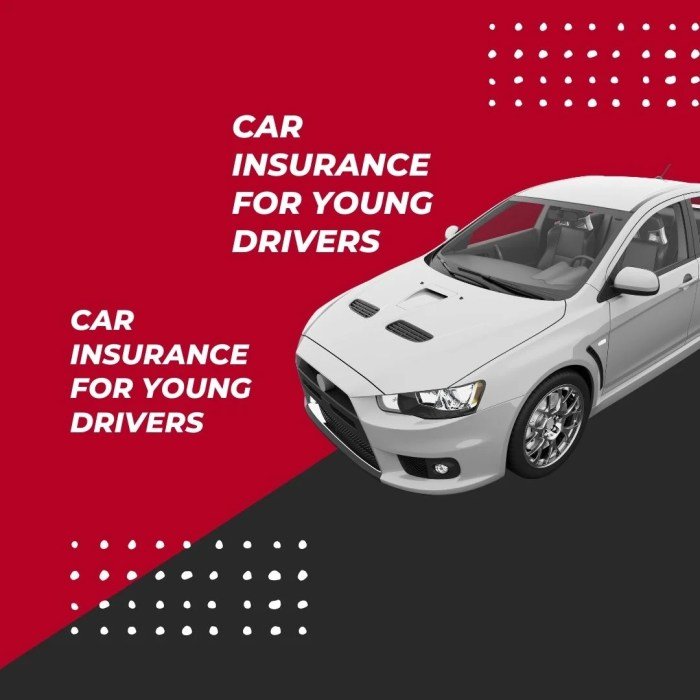How to Find Affordable Car Insurance for Young US Drivers
How to Find the Most Affordable Car Insurance for Young Drivers in the U.S. is a question many young adults grapple with. The cost of car insurance can seem daunting, especially when you’re just starting out and building your driving record. This guide will walk you through the process of finding the best and most affordable car insurance options, helping you navigate the complexities of insurance policies and pricing structures tailored to young drivers.
We’ll explore key factors affecting your premiums, including your driving history (or lack thereof), the type of vehicle you drive, and even your location. We’ll also cover how to leverage online comparison tools, negotiate with insurance providers, and understand the often-confusing jargon of the insurance world. By the end, you’ll be empowered to make informed decisions and secure the most affordable car insurance that fits your needs and budget.
Table of Contents
ToggleUnderstanding Young Driver Risk Factors
Insurance companies view young drivers as statistically higher risk than older, more experienced drivers. This higher risk translates directly into higher insurance premiums. Several factors contribute to this assessment, and understanding them can help young drivers find more affordable coverage.Insurance companies use a complex algorithm to assess risk, factoring in various elements to determine premiums. These factors are not equally weighted, and the relative importance can vary between insurers.
However, certain factors consistently play a significant role.
Driving History
A lack of driving history is a major factor driving up insurance costs for young drivers. Insurance companies rely on historical data to predict future behavior. Without a proven track record of safe driving, they must assume a higher level of risk. This is why many insurers offer discounts for good student records, completion of defensive driving courses, and even for maintaining a clean driving record for a specific period (after obtaining a license).
The longer a young driver maintains a clean driving record, the more their premiums will likely decrease over time. A single accident or traffic violation can significantly impact premiums, especially in the early years of driving.
Age Group Differences
The risk associated with young drivers isn’t uniform. The 16-18 age group is generally considered the highest risk due to inexperience and a higher propensity for accidents. Statistics consistently show that this age group is involved in more accidents per mile driven than older drivers. The 19-25 age group represents a somewhat lower risk, but still higher than older drivers.
As drivers gain experience and mature, their risk profile improves, leading to lower premiums. This improvement is reflected in the gradual decrease in insurance rates as drivers age into their twenties and beyond.
Vehicle Type
The type of vehicle a young driver chooses significantly impacts insurance costs. High-performance vehicles, sports cars, and vehicles with a history of theft or accidents are typically associated with higher insurance premiums. These vehicles are often more expensive to repair, and their higher value increases the potential payout for insurance claims. Conversely, choosing a less expensive, smaller, and less powerful car can result in lower insurance premiums.
For example, insuring a used Honda Civic will generally be cheaper than insuring a new BMW M3. Insurance companies consider factors such as the vehicle’s safety rating, repair costs, and theft rate when calculating premiums.
Exploring Insurance Options
Finding the right car insurance as a young driver can feel overwhelming, but understanding your options and comparing prices is key to securing affordable coverage. This section will explore the different types of car insurance available, compare pricing structures from various providers, and highlight potential discounts you might qualify for.
Finding cheap car insurance as a young driver in the US can be tough, but it’s definitely doable. A big part of it involves understanding your options and comparing quotes. For a comprehensive overview of the process, check out this helpful guide: A Guide to Choosing Car Insurance for First-Time Car Buyers in America. This guide will help you navigate the complexities of insurance, ultimately leading you to find the most affordable option for your needs.
Common Car Insurance Types and Coverage
Several types of car insurance policies offer varying levels of protection. Choosing the right one depends on your budget and risk tolerance. Understanding the coverage each provides is crucial for making an informed decision.
Finding cheap car insurance as a young driver can be tough, especially if you’re juggling bills. Your credit score plays a big part, so understanding how it impacts your rates is key. Check out this resource on The Best Car Insurance for Drivers With Bad Credit in America to learn more. Then, compare quotes from multiple insurers to find the best deal for your situation, focusing on factors like coverage and deductibles to manage costs effectively.
| Insurance Type | Coverage | Typical Cost Range | Discount Availability |
|---|---|---|---|
| Liability | Covers injuries or damages you cause to others in an accident. This is usually legally required. | $500 – $2000 annually (varies greatly by state and driving record) | Yes (Good Driver, Multi-Car) |
| Collision | Covers damage to your car, regardless of fault, in an accident. | $500 – $1500 annually (varies greatly by car value and driving record) | Yes (Good Student, Safe Driver, Anti-theft devices) |
| Comprehensive | Covers damage to your car from events other than accidents, such as theft, vandalism, or natural disasters. | $200 – $800 annually (varies greatly by car value and location) | Yes (Garaging in secure location, Anti-theft devices) |
| Uninsured/Underinsured Motorist | Protects you if you’re hit by an uninsured or underinsured driver. | $100 – $500 annually (often bundled with liability) | Yes (Good Driver) |
| Medical Payments | Covers medical expenses for you and your passengers, regardless of fault. | $100 – $500 annually (often bundled with other coverages) | Yes (Good Driver) |
Pricing Structures of Different Insurance Providers
Insurance companies use various factors to determine your premiums, including your age, driving history, location, and the type of car you drive. Young drivers are often considered higher risk, leading to higher premiums. However, significant differences exist between insurers in their pricing models for young drivers. For example, some companies may prioritize safe driving habits over age, while others might offer more competitive rates in specific geographic areas.
It’s crucial to obtain quotes from multiple providers to compare prices. Consider checking companies like State Farm, Geico, Progressive, and Allstate, as well as smaller regional insurers.
Discounts for Young Drivers
Many insurance companies offer discounts to reduce premiums for young drivers who demonstrate responsible behavior or take preventative measures. These discounts can significantly lower your overall cost.
| Discount Type | Description | Example |
|---|---|---|
| Good Student Discount | Maintaining a high GPA in school often qualifies you for a discount. | A 15-25% reduction in premiums for students with a GPA above 3.0. |
| Safe Driver Discount | Companies may offer discounts for drivers with clean driving records and no accidents or tickets. | A 10-20% reduction in premiums for drivers with no accidents or tickets in the past 3 years. |
| Defensive Driving Course Discount | Completing a state-approved defensive driving course can demonstrate your commitment to safe driving. | A 5-15% reduction in premiums after course completion. |
| Telematics Programs | These programs use devices or apps to monitor your driving habits, rewarding safe driving with lower premiums. | Discounts based on driving scores, with better scores leading to lower premiums. |
| Bundling Discounts | Combining auto insurance with other types of insurance (home, renters) from the same company often leads to savings. | A 5-10% discount for bundling auto and renters insurance. |
Utilizing Online Comparison Tools
Finding affordable car insurance as a young driver can feel overwhelming, but thankfully, technology offers a powerful ally: online comparison tools. These websites streamline the process of obtaining quotes from multiple insurers, saving you valuable time and effort while potentially uncovering significant savings. They work by collecting your information once and then sending it to various insurance providers who then provide you with personalized quotes.Online comparison websites offer several key benefits.
They allow you to compare quotes side-by-side, making it easy to identify the most competitive options. This transparency empowers you to make informed decisions based on price, coverage, and other important factors. Furthermore, these tools often provide access to insurers you might not have considered otherwise, broadening your options and increasing your chances of finding a better deal.
Reputable Online Car Insurance Comparison Tools
Several reputable websites offer car insurance comparison services. Examples include NerdWallet, The Zebra, and Policygenius. These platforms generally partner with a wide range of insurance companies, ensuring you have access to a diverse pool of options. While these are just a few examples, it’s important to research and compare different websites to find one that best suits your needs and preferences.
The specific insurers listed on each site may vary.
Limitations of Online Comparison Tools
While incredibly useful, relying solely on online comparison tools has potential drawbacks. These tools often present simplified versions of insurance policies, potentially omitting crucial details. It’s essential to carefully review the full policy documents from any insurer before committing. Additionally, the quotes provided are often estimates, and the final price may vary slightly based on factors not initially considered by the comparison tool.
Finally, the selection of insurers presented might not be exhaustive, meaning you could miss out on a potentially better deal offered by a company not listed on the platform.
Using an Online Comparison Tool: A Step-by-Step Guide, How to Find the Most Affordable Car Insurance for Young Drivers in the U.S.
Using an online comparison tool is generally straightforward. First, you’ll need to provide some basic information, including your age, driving history, location, the type of car you drive, and your desired coverage levels. Next, the website will query its network of insurers and provide you with a list of quotes, typically sorted by price. Carefully compare the details of each quote, paying close attention to coverage limits, deductibles, and any additional fees or features.
Finally, before making a decision, it’s crucial to visit the insurer’s website directly to review the full policy details. This ensures you fully understand the terms and conditions before purchasing your insurance. Remember to compare apples to apples – ensuring the coverage levels are similar across all quotes before making a decision based solely on price.
Finding cheap car insurance as a young driver in the US can be tough, but there are ways to save. Comparing quotes from multiple insurers is key, and you might find helpful resources by checking out sites like AdminLurp which can offer insights into insurance options. Remember to maintain a good driving record and consider factors like your car’s safety features to lower your premiums.
Negotiating with Insurance Providers
Securing affordable car insurance as a young driver often involves more than just comparing quotes online. Negotiating directly with insurance providers can significantly impact your final premium. By understanding your leverage and employing effective communication strategies, you can potentially save a considerable amount of money.Effective negotiation hinges on presenting yourself as a low-risk driver and demonstrating your commitment to safety.
This involves clearly communicating your driving history, safety features in your vehicle, and any defensive driving courses you’ve completed. Remember, insurance companies are ultimately in the business of assessing risk, and showcasing your responsible driving habits is key to achieving a lower premium.
Strategies for Negotiating Lower Premiums
Several strategies can be employed to negotiate lower insurance premiums. These include bundling policies, exploring discounts, and demonstrating your commitment to safe driving. While not guaranteed to work in every case, these tactics significantly increase your chances of securing a better deal.
- Bundling Policies: Many insurers offer discounts for bundling multiple policies, such as car insurance and renters or homeowners insurance. This demonstrates your loyalty and reduces the administrative cost for the company, often resulting in lower premiums.
- Exploring Discounts: Inquire about all available discounts, including those for good student grades, safe driving courses (like defensive driving), and installing anti-theft devices. Some companies even offer discounts for vehicles with advanced safety features.
- Demonstrating Safe Driving: Highlight your clean driving record. If you’ve completed a defensive driving course, mention this explicitly. Emphasize your commitment to safe driving practices, such as avoiding speeding and adhering to traffic laws.
Communicating Your Driving Record and Risk Profile
Clearly and concisely presenting your driving history and risk profile is crucial. Avoid ambiguity and focus on positive aspects of your driving record. Providing evidence of safe driving habits, such as a clean driving record, can strengthen your negotiating position.For example, if you’ve completed a defensive driving course, provide a certificate as proof. If your vehicle has advanced safety features, mention them specifically.
Highlighting these factors reinforces your image as a low-risk driver, increasing your chances of a favorable outcome.
Questions to Ask Insurance Providers
Asking the right questions is vital in ensuring you receive the best possible deal. Don’t hesitate to inquire about specific aspects of the policy and potential savings.
- What discounts are available to me? This allows you to understand all potential savings opportunities.
- Can I bundle my car insurance with other policies for a discount? This explores the possibility of saving money by combining insurance products.
- What is the process for disputing a claim? This is essential for understanding your rights and responsibilities in case of an accident.
- What are the specific terms and conditions of the policy? This ensures you understand all aspects of the contract before agreeing to it.
Importance of Reading the Fine Print
Before signing any insurance policy, meticulously review the fine print. This includes understanding coverage limits, deductibles, exclusions, and any additional fees. Failing to do so can lead to unexpected costs and complications down the line. Pay close attention to the policy’s terms and conditions, ensuring you fully comprehend the agreement before committing to it. A thorough review safeguards your interests and prevents future disputes.
The Role of Credit Score
Many young drivers are surprised to learn that their credit score, a number representing their creditworthiness, can significantly impact their car insurance rates. Insurance companies use credit-based insurance scores (CBIS) to assess risk, believing that individuals with poor credit management might also be more likely to file claims or engage in risky driving behaviors. While this correlation isn’t always perfect, it’s a factor many insurers consider.Credit scores are calculated using a variety of factors including payment history, amounts owed, length of credit history, new credit, and credit mix.
A higher credit score generally indicates a lower risk to the insurance company, leading to lower premiums. Conversely, a lower credit score often results in higher premiums, as the insurer perceives a greater risk. This is because statistically, people with poor credit histories tend to have more accidents or claims than those with good credit. It’s important to remember that this is a statistical correlation, not a guarantee of individual behavior.
Credit Score Improvement Strategies to Lower Insurance Premiums
Improving your credit score can take time and effort, but the potential savings on car insurance can be substantial. Focus on consistent and responsible financial behavior. This includes paying bills on time, keeping credit utilization low (the amount of credit you use compared to your total available credit), and maintaining a diverse range of credit accounts. Avoid applying for multiple new credit accounts in a short period, as this can negatively impact your score.
Regularly checking your credit report for errors and addressing them promptly is also crucial. Paying down existing debts, particularly high-interest debt, can significantly boost your credit score.
Resources for Checking Credit Score and Understanding Its Impact on Insurance
Several reputable resources can help you understand your credit score and its impact on insurance. AnnualCreditReport.com is a website authorized by the federal government that allows you to access your free credit reports from the three major credit bureaus (Equifax, Experian, and TransUnion) once a year. You can also obtain your credit score from these bureaus, though often for a fee.
Many credit card companies and financial institutions also provide free credit score access to their customers. Contacting your insurance provider directly to inquire about their specific credit scoring practices and how it impacts your premiums can also provide valuable insights.
Hypothetical Example of Credit Score Impact on Insurance Costs
Let’s imagine two 20-year-old drivers, both with similar driving records and the same car. Driver A has an excellent credit score of 780, while Driver B has a fair credit score of 620. Both receive quotes from the same insurance company. Driver A might receive an annual premium of $1,800, while Driver B might receive a quote of $2,500 – a difference of $700 annually.
This significant difference illustrates the potential financial impact of credit score on car insurance costs. This is a hypothetical example; actual savings will vary based on numerous factors, including location, coverage level, and the specific insurance company.
Financial Planning for Car Insurance: How To Find The Most Affordable Car Insurance For Young Drivers In The U.S.

Source: co.uk
Securing affordable car insurance as a young driver requires careful financial planning. It’s not just about finding the cheapest policy; it’s about integrating the cost into your overall budget and preparing for unexpected expenses. This proactive approach ensures you can maintain coverage without jeopardizing your financial stability.
Budgeting Strategies for Car Insurance
Creating a realistic budget is crucial. Start by gathering information on potential insurance costs. Use online comparison tools to get quotes from different providers, factoring in your driving history, vehicle, and location. Once you have a range of estimated costs, incorporate the average monthly premium into your overall budget. Consider using budgeting apps or spreadsheets to track your income and expenses, ensuring car insurance payments are accounted for each month.
Remember to allocate funds for any potential increases in premiums, as these can occur due to various factors, such as traffic violations or at-fault accidents.
Saving for Unexpected Car Insurance Expenses
Unexpected car-related expenses are common. A minor accident, even one not your fault, can lead to higher premiums or deductibles. Similarly, changes in your driving record or increases in insurance rates can significantly impact your budget. Therefore, building an emergency fund specifically for car insurance is essential. Aim to save enough to cover at least three months’ worth of premiums.
This financial cushion provides security during unexpected circumstances, preventing you from falling behind on payments or canceling your insurance altogether.
Managing Car Insurance Costs on a Limited Budget
Several strategies can help manage car insurance costs effectively. Maintaining a good driving record is paramount, as this directly impacts your premiums. Consider increasing your deductible; while this means you’ll pay more out-of-pocket in the event of an accident, it typically results in lower premiums. Explore discounts offered by insurance companies, such as good student discounts, safe driver discounts, or bundling home and auto insurance.
Compare quotes regularly to ensure you’re getting the best possible rate and don’t hesitate to switch providers if you find a more affordable option.
Sample Monthly Budget Incorporating Car Insurance
A sample monthly budget can illustrate how car insurance fits into overall financial planning. Let’s assume a young driver’s monthly expenses include rent ($800), groceries ($300), utilities ($150), student loan payments ($200), entertainment ($100), and a car insurance premium of ($150). This leaves approximately $700 remaining after covering these essential expenses (assuming a monthly income of $2500). This example highlights the importance of careful budgeting and prioritization.
The $700 remaining can be used for savings, debt repayment, or other expenses. However, it is crucial to note that this is a simplified example and actual expenses will vary depending on individual circumstances.
Conclusion
Finding affordable car insurance as a young driver requires research, planning, and a bit of savvy negotiation. By understanding the factors that influence your premiums, utilizing online comparison tools effectively, and actively engaging with insurance providers, you can significantly reduce your costs. Remember to compare quotes from multiple insurers, consider bundling policies, and always read the fine print before signing on the dotted line.
With a little effort, you can find the right coverage at a price that works for you.
FAQ Summary
What is a deductible?
Your deductible is the amount you pay out-of-pocket before your insurance coverage kicks in after an accident.
Can I get car insurance without a driving history?
Yes, but it will likely be more expensive. Insurers assess risk based on various factors, and lack of driving history is often viewed as higher risk.
How often can I change my car insurance provider?
You can usually switch providers whenever your current policy expires. Some insurers may have early termination fees.
Does my credit score affect my car insurance rate?
In many states, yes. A lower credit score can lead to higher premiums.



